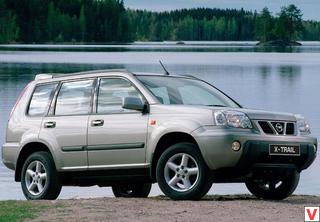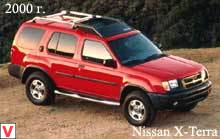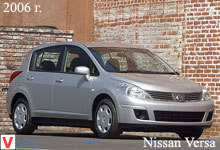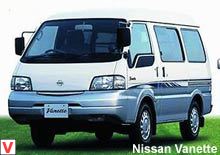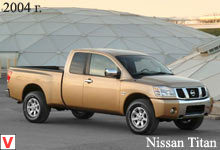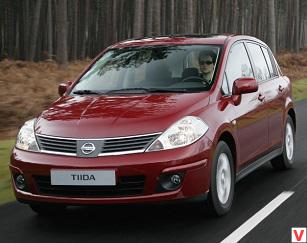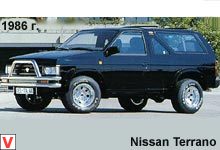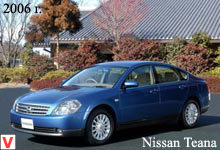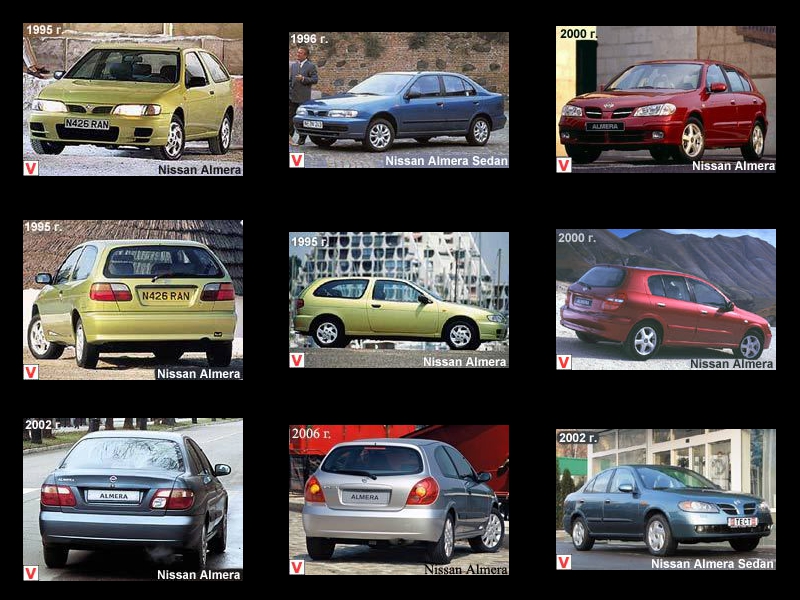
Almera is a reliable and unpretentious golf-class car, with low cost and a balanced set of consumer qualities. Replaced the model Nissan Sunny. The first show took place in 1995 in Frankfurt. Almera was originally offered in a 3-door and 5-door hatchback, but in early 1996 a 4-door sedan appeared.
The interior and body design was developed under the direction of Nissan’s European technology center in Grenfield. The modest but attractive appearance of the three- and five-door hatchbacks is underlined by the raised middle part of the body, the powerful rear rack and the high roofline. The front part of the body is strongly oblique, the angle of inclination of the bonnet line, gradually increasing, smoothly passes into the windshield. Rear compact wheel suspension borrowed from the model Maxima QX. Passive safety: longitudinal energy absorbing elements are built into the frame.

The standard equipment includes airbags for the driver and front passenger, as well as seat belts with a tightening mechanism. The interior is different functionality. Four-cylinder 16-valve engines with a working volume of 1.4 and 1.6 liters from the Sunny model have been upgraded and now develop significantly greater power (respectively 75 and 90 hp) in the low-speed range, which contributed to faster acceleration. Since 1996, the Nissan Almera began to install a 2.0-liter diesel engine with 75 hp. And also there was a modification 3-door hatchback Almera GTI with a high-speed two-liter engine with 143 hp.
In the fall of 1998, the Nissan Tino, a compact minivan based on the Sunny model (Japanese version of the Nissan Almera), was first introduced. In the same year, Almera was restyled, and in March 1999 a new generation of Nissan Almera II debuted in Geneva. Now this car has become a “European” - it is produced at the plant in Sunderland in the UK, and the capacities of the design centers of Japan and Europe were involved in the development. A completely new MS-type platform for the Almera II has retained the old wheelbase of 2335 mm. The dimensions have increased slightly: the new car has become wider (about 20 mm), higher (55 mm) and longer than the previous model.
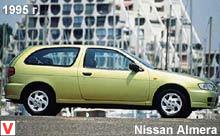
Hatchback length 4184 mm, sedan 4425 mm. Updates have touched and appearance, and interior. Exterior Almera II has become more modern. The dynamic hood and rear wings give the impression of movement, even when the car is standing. The characteristic "nostrils" of the grille not only attracts attention to the emblem, but also clearly show the family resemblance to the successfully launched earlier Nissan Primera. To succeed in the most difficult for the competition C-class, where Nissan Almera confronted rivals such as the Opel Astra, Volkswagen Golf and Ford Focus, Japanese and English designers had to create a truly memorable image.
The sporting theme of body styles echoes the characteristics of high technology, and the hatchback roofline has already received the name “surfing tail” among specialists. In addition to aesthetic tasks such a roof also serves as a spoiler, increasing the efficiency of air flow. The design of the car was designed with the new security system. The MS platform consists of two clearly separated zones: the impact energy absorption zone and a strong and safe cocoon for the driver and passenger. Applying laser welding in the production of the body and using the enlarged panels, the engineers were able to increase the rigidity of the body by 30% than its predecessor.

Increased passive safety of front passengers. The car is equipped as standard with head restraints of the active type (when struck from behind, the head restraints move forward, protecting the passenger's neck from injury). There are airbags to protect the head and chest, the back seat is equipped with three seat belts. Improved safety also contributes to the improvement of safety: four-sector headlights, integrated reflectors installed on the rear lights, and quickly turn on the light-emitting diodes of the brake light.
Fully independent suspension of all wheels provides high driving performance and level of comfort. The layout of the dynamic body allows you to comfortably accommodate the driver and four passengers. The hatchback trunk volume has been increased from 0.34 to 0.355 m3 (including five passengers). The salon is pleasantly impressive with a sophisticated front panel ergonomics, well-read instruments, a complete lack of squeaks, comfortable, hard-seats in German. Well thought out various elements and accessories that create coziness and comfort for the owner of this machine.
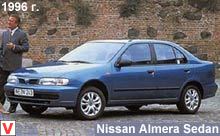
The original satellite navigation system 3D Bird VIEW is used with an automatically extended screen and the “bird flight” function (an image of the road and your car on it from a bird's eye view). Completely replaced power units. The base was the new petrol 1.5-liter 16-valve engine producing 90 hp. More powerful 1.8-liter engine in 114 hp installed with a mechanical or hydromechanical automatic transmission.
On this small class car for the first time applied such technical innovations as the Valve Timing Control System, which allows you to continuously change the valve timing, while improving the torque characteristics depending on the load and improving the speed qualities of the car. The direct ignition system developed by Nissan reduces emissions. The economy version is equipped with the newest 2.2-liter 4-cylinder 16-valve turbocharged diesel engine with direct fuel injection of 110 hp. It is completed only with a manual transmission. Almera II is suitable for lovers of active driving style.
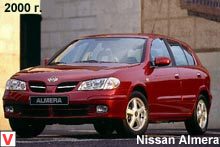
Its rear suspension is made multi-link, which allows the wheels to almost always remain perpendicular to the road surface. This not only improves handling, but also improves vehicle safety. The braking system has been improved by installing disc brakes on all wheels, as well as the use of Bosh anti-lock system in conjunction with the Brake Assist system, which provides the ability to quickly output the braking mode when ABS is activated. The system begins to act immediately before the ABS is triggered, the instruments calculate the difference between the speed of the front and rear wheels and eliminate the blocking of the rear wheels.
Nissan Almera II generation has become the new most important model of the company in the most massive European segment of C. In our country, such cars are in particular demand because they offer a unique combination of maneuverability, comfort and quality. The car is distinguished by good corrosion resistance, rust, as a rule, appears only after unqualified body repair. The vehicles assembled in the UK use the standard Nats anti-theft system, including remote control for door opening and engine immobilizer, as well as an integrated audio protection system.
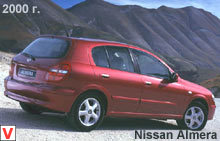
Depending on the level of configuration, two types of audio systems are offered, a CD changer for six CDs. The next edition of the second-generation Nissan Almera, launched in 2000, was introduced in the fall of 2003 at the Paris Motor Show. The car was still assembled at the plant in Sunderland in the UK, as well as the previous version. Dynamic and stylish, it combines an updated appearance and advanced technical developments, as well as the quality and reliability inherent in all cars of this brand, which gives it every chance to strengthen its leading position in the “C” segment.
The European design studio Nissan in Germany, the European technology center Nissan in the UK, the technology center Nissan in Japan, as well as several independent European studios contributed to the creation of the appearance of the new Almera. External changes are not many, but they are clearly visible. The main changes in the appearance of the car relate to the front and rear.

The updated front end gives the car a completely new, distinctive image, in style bringing it closer to the new Primera. On both sides of the grille of rapid shape, typical for the design of Nissan cars, there are new spectacular projector-type headlamps with stylish, transparent glass lenses. Reflectors have titanium rims, which gives the car a modern high-tech look. Changes to the front of the car include a new pointed bumper, the same as in the latest Primera. In the lower part of the bumper there is a wide air intake opening and searchlight-type fog lamps on each side. Upgraded rear of the car, including completely redesigned bumper, emphasizing the updated taillights.
Ultra-modern direction indicators, parking lights, brake lights and rear fog lamps are combined into a block lamp. The updated Almera is equipped with a ten-spoke 16-inch alloy wheels or, depending on the modification, alloy wheels with seven-spoke caps. In the colors of the body Almera, consisting of ten primary colors, added five new ones. alloy wheels with seven-spoke caps. In the colors of the body Almera, consisting of ten primary colors, added five new ones. alloy wheels with seven-spoke caps. In the colors of the body Almera, consisting of ten primary colors, added five new ones. Almera, as before, is available as a three- and five-door hatchback, as well as a four-door sedan.

Configuration levels are now three: Сomfort - basic configuration, Luxury and Tekna, respectively, meaning "luxury" and "sports" configuration. Improved equipment and a modified car interior form the basis of technical innovations. The interior design is distinguished by “super utility” (Super Utility), which implies ultra-practicality, functionality.
Almera offers car buyers segment "C" finish of this quality, which usually offer cars of a higher class. Equipping a new Almera is also usually comparable only with luxury cars. In the unanimous opinion of experts, Nissan Almera is a modern leader in the number of additional cavities (over 20): various containers, glove boxes, pockets and holders for any things that the driver and passengers can take to the salon. A case for glasses is located above the rearview mirror so that the driver does not have to take his eyes off the road. Soft upholstery eliminates damage to the glasses, and a special mechanism ensures a smooth opening.
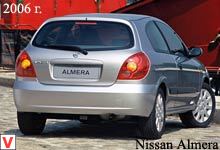
Door pockets are excellent places for storing small items that should always be at hand. The drawer in the armrest is a convenient place to store the necessary things. In the rear armrest is a reclining table with two cup holders and a compartment for a children's electronic toy. and a special mechanism ensures smooth opening.
Door pockets are excellent places for storing small items that should always be at hand. The drawer in the armrest is a convenient place to store the necessary things. In the rear armrest is a reclining table with two cup holders and a compartment for a children's electronic toy. and a special mechanism ensures smooth opening. Door pockets are excellent places for storing small items that should always be at hand.
The drawer in the armrest is a convenient place to store the necessary things. In the rear armrest is a reclining table with two cup holders and a compartment for a children's electronic toy. The seats, steering column and pedals are arranged so as to make the driver's seat as comfortable as possible. Adjustable lumbar support for the driver's seat is a standard feature for all modifications. All major appliances are within 30 degrees from the line of sight. This allows you to spend much more time behind the wheel, without suffering from back pain. The seats in Almera are made of new material. Unusually look new chetyrehpitsevoe steering wheel and gear lever.
The dashboard has changed quite a lot, with the display in the center of a new communication and information system N-form, which makes Almera a unique car in its class. The n-form is an advanced, fully integrated control system for the audio system, on-board computer, and air conditioning system, was first installed on cars Nissan Primera. A five-inch display is built into the N-Form console, showing temperature, time, audio settings, and other information for the driver. The central switch - “joystick” allows the driver to select different modes on the display, while the other buttons perform different functions depending on the selected mode.
The N-Form is included in the standard equipment of the Luxury and Tekna versions, as well as in the standard built-in radio, CD- single disc player and climate control system. As an option, Almera can also be equipped with a Stability Program (ESP). The central switch - “joystick” allows the driver to select different modes on the display, while the other buttons perform different functions depending on the selected mode. The N-Form is included in the standard equipment of the Luxury and Tekna versions, as well as in the standard built-in radio, CD- single disc player and climate control system. As an option, Almera can also be equipped with a Stability Program (ESP).
The central switch - “joystick” allows the driver to select different modes on the display, while the other buttons perform different functions depending on the selected mode. The N-Form is included in the standard equipment of the Luxury and Tekna versions, as well as in the standard built-in radio, CD- single disc player and climate control system. As an option, Almera can also be equipped with a Stability Program (ESP). The autumn modernization of 2002 affected both the appearance and the main units and assemblies.
The new Almera has received 2 new gasoline engines: a 1.5-liter engine with 72 kW (98 hp) and a 1.8-liter engine with 85 kW (116 hp). A 5-speed manual transmission is standard for the entire range of petrol engines, while for a 1.8-liter engine there is also a 4-speed automatic transmission. Both gasoline power units provide up to 97% of the maximum torque at low engine speeds - at 2400 rpm, while the maximum speed at 1.5-liter increased to 177 km / h, and the acceleration time to 100 km / h was reduced by more than for half a second and is 13.1 seconds.
While the maximum speed of the 1.8-liter engine remained 186 km / h, acceleration time from 0 to 100 km / h was reduced to 10.8 seconds, and from 100 to 120 km / h in fourth gear - to 5.9 seconds. High-tech solutions that are new for cars of this class, for example, swirl flaps on gasoline engines and a variable valve timing system on a 1.8-liter engine, ensure low fuel consumption. Theoretically, the resource of one tank on a car with an engine of 1.5 liters is enough for 909 km of run. Since January 2003, Nissan has been offering its customers another diesel modification of the Nissan Almera model.
The novelty received a new 1.5-liter turbodiesel engine, equipped with the common rail direct injection system. The power of this unit is 60 kW (82 hp), and the maximum torque of 185Nm is reached at 2,000 rpm. With the new engine, the Nissan Almera accelerates from zero to one hundred kilometers per hour in 14.4 seconds, and its maximum speed is 168 kilometers per hour. The average fuel consumption of a car with a 1.5-liter turbodiesel is only 4.7-liters per hundred kilometers. All four engines meet the toxicity standards adopted in Europe at the moment, as well as the new CED III standards that came into force in 2001.
In addition, gasoline engines also meet the standards that will come into effect in 2005. Designed to improve dynamic performance, save fuel, reduce emissions and enjoy driving at any speed, the new series of engines, like Almera itself, is exclusively of European origin. The car exceeds the requirements of the latest directive of the European Council on the frontal impact and focuses on much higher standards Euro-NCAP, which are sponsored by the six largest automotive and government organizations in Europe. The car also features the latest security features unique to this class.
The body of Almera is clearly divided into two zones, one of which is designed to wrinkle in given directions, and the other - to remain intact under any circumstances. New power elements are programmed to prevent deformation of the passenger compartment and reduce the risk of internal movements of the instrument panel, steering column and floor. The system does not contain pyrotechnic cartridges, works exclusively by kinematics, and, therefore, can be reused. Currently it is only available with side airbags. Side airbags, unlike traditional driver and passenger airbags, must throw a person away from the impact zone and therefore require particularly quick response.
The side airbag is activated by two sensors. Their shock detection time is less than 8 ms, and the full release of the pillows takes less than 30 ms. The pillow itself is installed in the seat back. For the driver, there is a 54-liter airbag installed in the steering wheel and a 110-liter front passenger airbag installed in the upper part of the front panel. The airbag for the passenger turns up and back, giving extra time for full deployment before it comes in contact with the passenger.
The design of the front seat belts on the new Almera has been modified to work according to the operation of airbags. Adjustable seat belts have some of the most powerful and fast-acting pyrotechnic pretensioners. The belt tensioning system also includes a pressure limiter on the human body to prevent injuries. The integrated reflectors used in the rear lights and the LCD brake light provide good visibility to the rear, which leads to a reduction in the stopping distance of the car traveling behind by the entire length of the car. Active safety provides additional control over the car in emergency situations.
Systems such as ESP, ABS, EBD and Nissan Brake Assist will provide the driver with the necessary assistance and will avoid accidents. The ESP + ESP + system combines an anti-lock braking system as well as a traction control system for maximum safety, regardless of road conditions. Almera offers a huge selection of devices and systems of standard and optional equipment. Air conditioning, power windows, panoramic mirrors, power steering, electric sunroof and a variety of audio systems will allow you to build exactly the car that suits your individual taste.
Almera has the same anti-theft system and immobilizer as Primera - a car of a higher class. The chassis has retained the classic version: an independent front suspension with McPherson struts and a rear multi-link beam. Reducing noise and vibration was one of the most important tasks in the development program of the updated Almera. In 2012, the third generation Nissan Almera was introduced. Having lived its second life in the form of the Korean Classic sedan, the new Almera appeared before us in a “budget” reading and with a Russian registration, the sedan is assembled on a full cycle in Togliatti. For the first time Nissan came up with a model specifically for Russia.
Almera has solid dimensions: length - 4656 mm, wheelbase - 2700 mm, height - 1522 mm and width - 1695 mm. Ground clearance is 160 mm. The curb weight of the car is 1198 - 1224 kg. With such a generous wheelbase trunk volume was 500 liters. The trunk opening is large enough, the loading height is 700 mm for a car with a manual gearbox and 710 for a car with an “automatic”.
The appearance of the third generation Almera at first glance is identical to the second generation Bluebird Sylphy model, but the body didn’t reach the AvtoVAZ conveyor: the panels are common, the geometry is general, and the power structure is different: the rigidity is increased due to other spars and the engine shield, the thicker floor another form, "kerchiefs", 27 new points of welding, as well as a mass damper in the rear part - this is a small step, which ends the roof. The round shapes of Almera III are noticeably spiced with chrome.
This brilliant metal trimmed the door handles, the edging of the side glazing and, of course, the grille - the main stylistic element, unequivocally referring us to the older "sister" Nissan Teana. The car is based on the Renault Logan platform, from which the engine, transmission and some other technological solutions are borrowed. True, with some very significant changes. So, another subframe is installed, the rear suspension beam is thicker and stiffer, the springs are also stiffer, the shock absorbers have other settings, the brake system supports are larger. Salon five.
Behind the place abound. From the rear seat cushion to the ceiling, 91 cm. The distance between the back of the front seat and the rear cushion is 64 cm. In the car, there is practically no central tunnel, the sofa is even, without a protrusion in the middle, so the third place is not real, but real. The back of the back of the sofa does not fold, so the ability to increase the trunk in this model is not. The interior is very much the same Logan.
Trim budget and austere. In the interior everything is done very simply and without frills. The front panel, the “tidy” with two laconic dials, the “petals” of the air ducts and the buttons for the front windows on the center console - all borrowed from Logan. The only pride of the interior Almera - Nissan multimedia system. There is a port for flash drives and Bluetooth, and even navigation with Navtec maps. Such multimedia is a wealth of complete sets, and in the base one there is not even chrome edged deflectors, the insert in the MCP lever is made of gray plastic, and not under the metal. Instead of a simple audio system - a stub.
Initially, the sedan will be produced with only one engine option, but in the future it is planned to expand the range of engines. At the same time, only a four-cylinder petrol power unit with a displacement of 1.6 liters (1,598 cm ³) is available for the sedan. This motor is able to develop power up to 102 hp at 5750 rev / min, as well as 145 Nm of torque at 3750 rev / min. Two transmissions - a five-step "mechanics" and a four-step "automatic". The sedan accelerates to 100 km / h in 10.9 seconds from the 5MKPP and 12.7 seconds from the 4AKPP. The maximum speed is 185 km / h.
The engine meets the environmental standards of the Euro-4 standard and, moreover, it is quite economical. The average fuel consumption declared by the manufacturer will be about 8.5 liters per 100 km in mixed driving mode. As part of the work on Almera for Russia, they added a full-fledged spare tire and a handle for closing the trunk lid. In the cabin there is a lever that actuates a cable drive, and the lid jumps high enough, but it is on the floor.
Outside the trunk can only be opened with a key.
